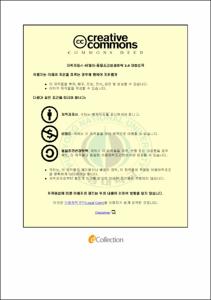초임계 함침 공정을 이용한 내마모성 Cu-PTFE 복합체의 제조 및 특성
- Alternative Title
- Synthesis and Characterization of Cu-PTFE Composites with Enhanced Tribology Properties using Supercritical Impregnation Process
- Abstract
- This study was attempted to develop the Cu-PTFE(polytetrafluoro -ethylene) composite with enhanced tribology property using supercriti -cal carbondioxide. Copper bis(trifluoroacetylacetonate) hydrate, Cu(hfa)2․H2O was adopted as copper precursor.
The supercritical synthesis process was composed of the impregnation of copper precursor and thermolytic reduction. The impregnation process was performed over a range of temperatures from 40 to 160 ?? and pressures from 120 to 200 bar. The reduction process was performed at 230 ?? and 250 bar for 2 hours consecutively after impregnation. Super -critical apparatus was consisted of a low-temperature bath, high pressure pump, two consecutive high pressure cylinders and auxiliary facilities. And a borescope to observe the inside of the cylinder was installed on it.
To determine the amount of copper precursors impregnated into PTFE, mass gain of the impregnated PTFE samples was measured by precision balance. To study cross-sectional morphology of synthesized Cu-PTFE composites, SEM(scanning electron microscopy) and TEM(transmi -ssion electron microscopy) were applied. For the preparation of TEM samples, PTFE films with 0.1 mm thickness were sliced to 140 nm by cryomicrotome at -140 ??.
The effect of the temperature on the impregnation ratio showed different behavior at higher than 120 ??. The impregnation ratio increased with the pressure up to 160 bar and showed similar values for the pressure range between 160 bar and 200 bar. These results are thought to originate from the dehydration reaction of Cu(hfa)2․H2O and the thermodynamical affinity difference of copper precursors for PTFE and supercritical carbon dioxide.
The equilibrium impregnation ratio at 160 bar was more than that of at 180 bar due to the thermodynamical affinity difference of Cu(hfa)2․H2O for carbon dioxide. And the impregnaion profile with time at 160 bar almost agreed with that at 180 bar.
Optimum conditions for the process impregnating PTFE with Cu(hfa)2․H2O was 120 ??, 160 bar. And the impregnation rate at optimum conditions was expressed as following equation.
From SEM images and EDS(energy-dispersive X-ray spectroscopy) analysis, it is turned out copper was penetrated inside the synthesized Cu-PTFE composite. SEM images showed that synthesised Cu-PTFE composite didn't reach impregnation equilibrium yet and copper particles were penetrated deeper at higher pressure. And from TEM images, it could be identified that the Cu-PTFE composite where copper particles were dispersed homogeneously could be made.
Finally, from tribology test for the Cu-PTFE composite with homoge -neously dispersed copper nano-particles, it was identified that the wear resistance was enhanced.
- Issued Date
- 2010
- Awarded Date
- 2010. 8
- Type
- Dissertation
- Publisher
- 부경대학교
- Department
- 대학원 화학공학과
- Advisor
- 주창식
- Table Of Contents
- 1. 서 론 1
2. 이 론 8
2.1. 초임계 유체와 초임계 공정 8
2.2. 초임계 함침 공정 13
2.2.1. 고분자의 기체 흡수에 대한 열역학적 접근 15
2.2.2. 고분자에 대한 확산 20
2.2.3. Fickian 확산의 수학적 접근 23
2.2.4. 초임계 이산화탄소를 이용한 함침 공정 26
2.3. 초임계 함침 공정을 이용한 나노 금속-고분자 복합체의 합성 공정 29
3. 실 험 31
3.1. 나노 구리-PTFE 복합체의 합성 실험 34
3.1.1. 초임계 함침 공정 34
3.1.2. 환원 공정 38
3.2. 나노 구리-PTFE 복합체의 마찰마모 시험 40
4. 결과 및 고찰 44
4.1. 나노 구리-PTFE 복합체의 합성 44
4.1.1. 초임계 함침 공정 45
4.1.1.1. 온도와 압력의 효과 45
4.1.1.2. 구리 전구체와 PTFE에 대한 함침평형 52
4.1.1.3. PTFE에 대한 Cu(hfa)2H2O의 함침속도 54
4.1.2. 초임계 환원 공정 64
4.2. 나노 구리-PTFE 복합체의 마찰마모 특성 68
4.2.1. 마찰 특성 68
4.2.2. 마모 특성 73
5. 결 론 78
Appendix 81
References 93
- Degree
- Doctor
- Files in This Item:
-
-
Download
 초임계 함침 공정을 이용한 내마모성 Cu-PTFE 복합체의 제조 및 특성.pdf
기타 데이터 / 2.16 MB / Adobe PDF
초임계 함침 공정을 이용한 내마모성 Cu-PTFE 복합체의 제조 및 특성.pdf
기타 데이터 / 2.16 MB / Adobe PDF
-
Items in Repository are protected by copyright, with all rights reserved, unless otherwise indicated.